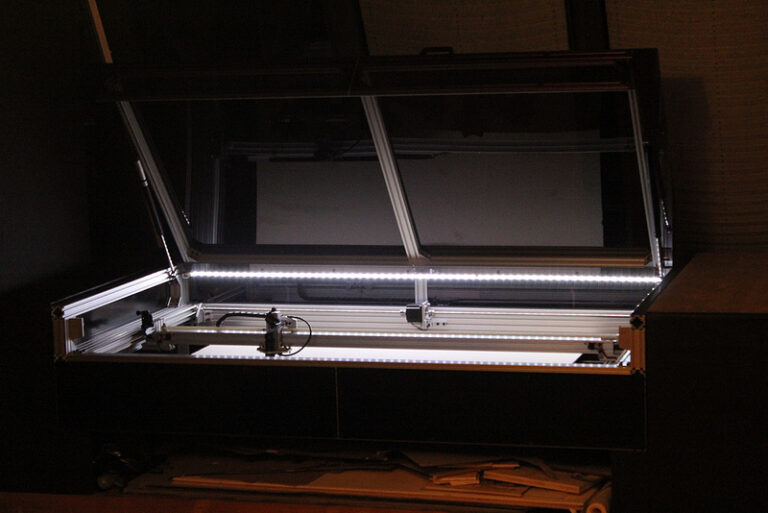By Tara Stratton
Addie Wagenknecht and Stefan Hachenberger, co-founders of NORDT
Labs, have many secret talents. Addie can bake some mean chocolate
chip cookies at 15,000+ feet in high winds on a mountain, and she
can open a beer bottle with just about anything (like a lighter)
thanks to Becky Stern. Stefan, on the other hand, makes the best
kiserschmann in Austria, according to Addie. But their most
recent projectthe Lasersaurshows their best talent yet.
The Lasersaur is an open source laser cutter. With CAD drawings,
circuit schematics, software and a bill of materials available from
NORTD Labs, end users can build these laser cutters themselves. The
Lasersaur was designed to fill the needs of makers, artists and
scientists who want a safe and highly capable machine.

Image credit: NORDT Labs
When Addie and Stefan designed the Lasersaur, they werent
interested in building the cheapest machine. They were interested
in building a platform that is sourceable worldwide, simple to
build, reproduce, duplicate and understand, dependable after
hundreds of hours of use, and safe. They want the end users to
truly own it and have access to all the designs that went into it.
We had spent thousands of hours on other peoples laser cutters
while in graduate school. We depended on the systems, yet they were
expensive and frustrating to use, said Addie. The software was
often horrible. We would have to run some obscure machine, running
CorelDrAW, and transfer everything from our OSX or Ubuntu systems to
do it. We felt like it could be done better, and for a lot less than
what it would cost to buy ready-made.
As a result of this experience, Addie and Stefan have written the
Lasersaurs open-source software and plug-ins from the ground up,
and according to Addie, they will do things you have never seen
beforeopen-source software or not. It is locally hosted and can
run off of any web browser, which means you don’t have to install
additional software or extensions to get it to cut. It’s plug and
play.
Addie and Stefan havent fully opened the source for the Lasersaur
yet, but hacker spaces in Philadelphia, Dublin and Tokyo; labs at
Carnegie Mellon, NYU and the University of São Paulo; and many
individuals have already built their own Lasersaur.
The Lasersaur is based on BeagleBone Black, powered by TIs Sitara
AM335x processor. Addie and Stefan chose this computer because they
were interested in continuing to work with and support Linux.
Since Ångström was pre-installed, we were able to continue to use
Ubuntu for the Lasersar. We found BeagleBone Black plays well with
USB peripherals like Wi-Fi dongles. It was rather painless to get
the Lasersaur image configured onto BeagleBone Black, so it felt
like a shoo-in. As a bonus, its globally available, stable, easy
to pick up, learn and hack, and the price is right! said Addie.
Lasersaurs are built to use 40-200 watt carbon dioxide lasers and to
have a bed size of 24 × 48 in (61 × 120 cm). They are comprised of
both stationary and dynamic parks. The primary building blocks of
both the frame and the ganty are T-slot aluminum extrusions bolted
together with M5 bolts and T-slot nuts. The Lasersaur is designed
around extrusions with 20, 40 and 80 mm side lengths. All of the
mount assemblies are built from angle brackets. A few parts are
custom-cut 6 mm acrylic (or more recently, aluminum) pieces. CAD
drawings for the acrylic parts are freely available and can be made
using a laser cutter – and should they fail, they may be replaced
with spare parts made by the Lasersaur itself. Aluminum versions of
those parts may be purchased from the NORTD Labs store, or users can
have them cut somewhere. No proprietary rails and carriage
assemblies are used. The Lasersaur carriages are built from
standard-sized ball bearings (with nylon coating), cap screws and
custom-cut acrylic or metal pieces.
According to Addie, the biggest issue has been funding. At first we
used Kickstarter. At some point far enough into development, we were
able to take fellowships and residencies to further fund the
project and push it forward. We also put our own money and time
into it. At some point, the community support allowed the project
to almost become self-sustained. We hope to get the financial and
social capital to 100% one day. University builds like that of
Carnegie Melon and New York University have been a big help to the
exposure of the project.
For more information about Lasersaur, visit Lasersaur.com.
Addie and Stefan have completed many other successful projects. To
find about more about them, visit the NORTD Labs website.
And definitely stay tuned: theyve been toying with an interesting
idea for an open-source industrial robotic arm!

